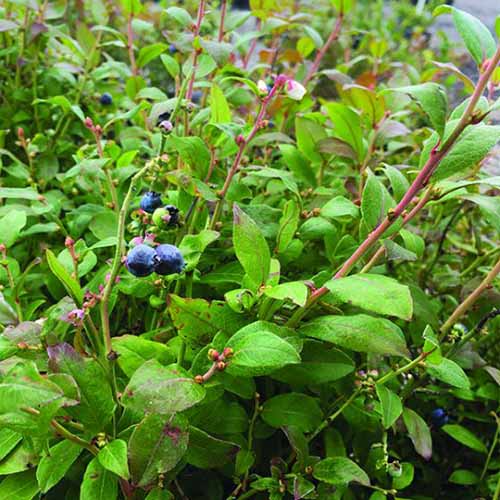Vaccinium angustifolium, V. myrtilloides
One of my favorite summer activities is roaming through the woodlands near my home in Vermont, foraging for lowbush blueberries.
A few summers ago, I decided to bring the berries to me and planted several V. angustifolium shrubs in my garden.
Lowbush blueberries are sweeter and hardier than their highbush counterparts, and fairly easy to grow.
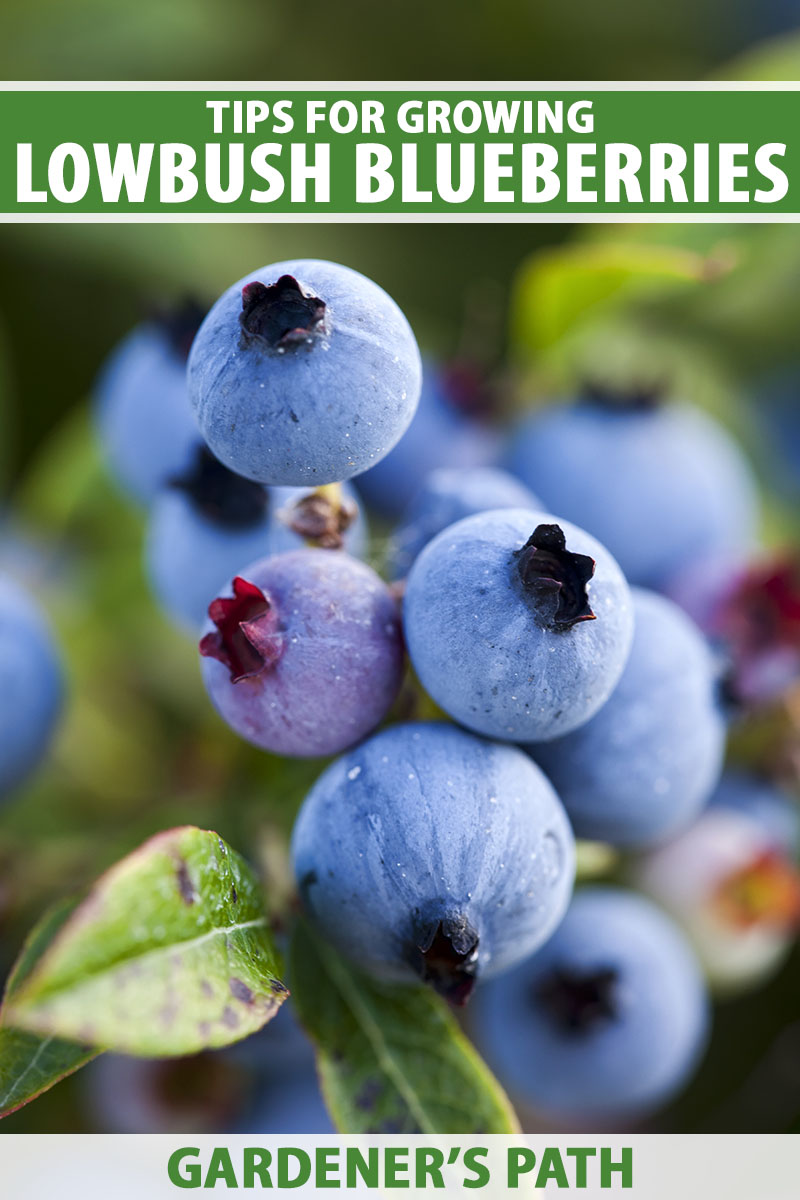
We link to vendors to help you find relevant products. If you buy from one of our links, we may earn a commission.
Also known as wild blueberries, these deciduous shrubs grow in dense groups, each spreading up to two feet tall and wide.
They have shallow fibrous roots spreading from long taproots, quarter-inch bell shaped white to pink flowers, and of course, small, delectably sweet berries that you can eat straight off the plant.
Read on to learn how to grow and care for lowbush blueberries in your garden.
What You’ll Learn
Cultivation and History
V. angustifolium, known as the lowbush or wild blueberry, can be found growing wild in the northeast United States and eastern and central Canada.
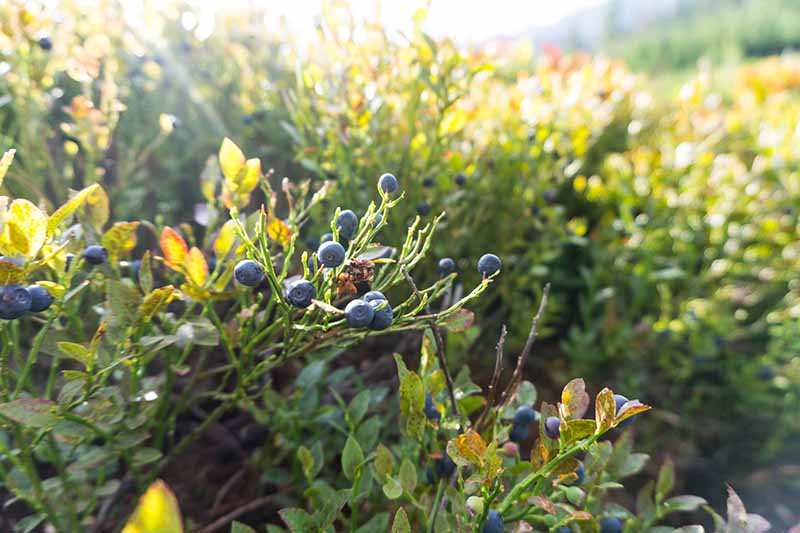
V. myrtilloides, often called ‘sour top’ blueberry, is a closely related species to V. angustifolium, and the two often hybridize.
Both species grow in similar climates, ranging south to the Smoky Mountains, west to the Great Lakes region, and north to Labrador and Newfoundland.
They are often found in eastern white pine, sugar maple, red maple, jack pine, and northern red oak forests as a prominent understory species.
Suitable for cultivation in USDA Hardiness Zones 2 to 8, these low-growing, frost tolerant species can handle harsh winter weather without damage, and are well suited for very cold climates.
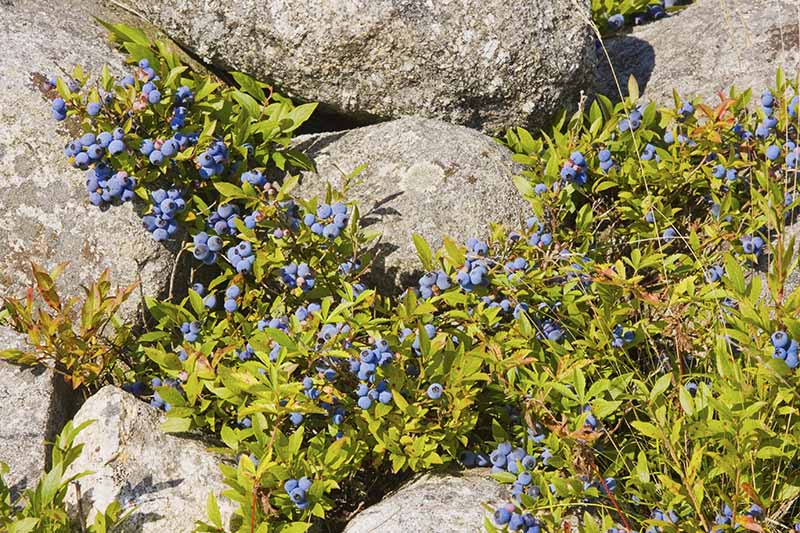
These low growing sprawling shrubs are not to be confused with the highbush blueberry, V. corymbosum, which can grow up to eight feet tall and produces larger berries.
If you are looking for a little of both, you can grow “half-high” hybrid cultivars.
You can learn more in our guide to growing blueberries.
Traditionally used for food and medicine by Native Americans, and later by European settlers, lowbush blueberries are now an important commercial crop, largely due to the rise of the frozen food industry in the 1940s.
They are often harvested commercially from managed wild stands, mainly for processing into berry-flavored products such as jam, wine, and ice cream.

In addition to use as a food source, these plants can also be used to rehabilitate disturbed sites and to prevent soil erosion on slopes.
Tolerant of heavy metals, lowbush blueberries have been used to recolonize strip-mined areas in West Virginia and reclaimed peatland mines in the Northeast.
Also useful for their ornamental value, they can be pruned into low hedges or planted as a slow growing ground cover.
What better way to cover up bare ground than with a field of blueberries!
Lowbush Blueberry Propagation
Lowbush types can be propagated in a number of ways, including from cuttings, rhizome division, nursery transplants, as sod, and from seed.
No matter the method, they should be planted in the early spring or fall.
From Stem Cuttings
Shrubs can be propagated from both hardwood and softwood cuttings.
Either select healthy stems from last year’s growth during late winter dormancy or new growth stems in early spring. Take five- to six-inch cuttings and remove all but the top couple of leaves.
Plant cuttings two inches apart in a one-gallon container filled with a half sand and half peat mix and keep warm and moist at around 70°F.
Set containers in a protected place out of direct sunlight. Cuttings should root within six weeks. Wait until after the last frost of spring to transplant out in the garden, as described below.
Rhizome Segments
In early spring or fall, carefully dig around an existing shrub, locating and cutting pieces of rhizomes about four to six inches long, making sure each piece has at least three buds.
Fill a flat with a half and half mix of sand and peat, and lay rhizomes horizontally on the surface, burying the bottom half.
Keep warm in a protected spot in part shade, with a temperature of around 70°F. Mist regularly to maintain moisture but don’t allow the potting medium to become waterlogged.
The plant will begin to root and sprout new growth from nodes in a few weeks, and can be transplanted out in the garden after last frost.
From Transplants
If all that work and waiting feels like too much, you can also purchase nursery starts as plugs or seedlings.
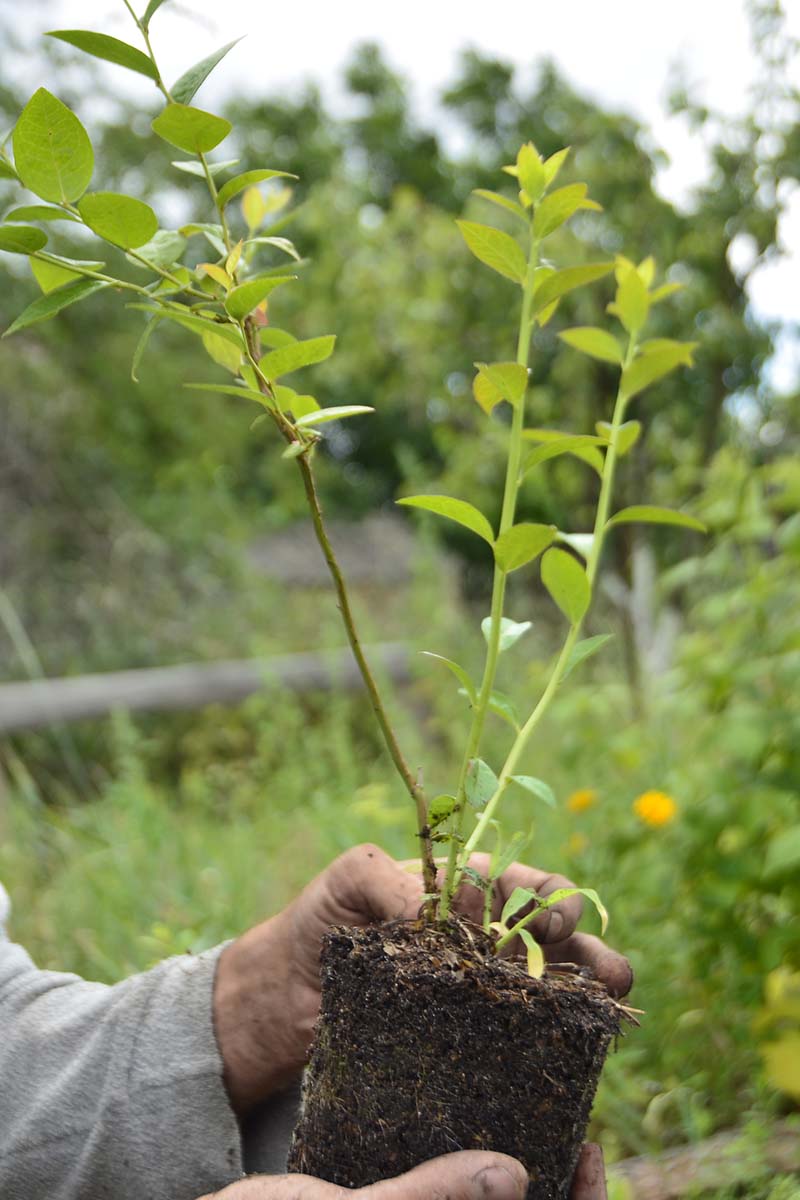
To plant, dig a hole a few inches deeper than the root system and twice as wide, place in the hole, and cover the roots with an equal mixture of soil and compost.
Since plants spread by creeping rhizomes, you can encourage spreading by covering one third of the aboveground stems with soil.
Water thoroughly and mulch with bark or sawdust to help retain moisture.
From Sod
Some nurseries sell lowbush blueberry sod, which are essentially slabs or rolls of soil with plants growing on them.
This is an easy option if you plan to use the plants as ground cover since results are instantaneous after planting.
To plant sod, dig a hole that is slightly wider than the slab and about about one and a half inches deep. If you dig the hole a bit deeper, you can add some compost to the bottom before placing the sod in the hole.
Lay the slab in the hole and cover any roots with soil amended with compost. Mulch with a thick layer of bark or sawdust, and water in thoroughly.
From Seed
It is possible to grow seeds collected from wild blueberry plants, but this takes incredible patience and is not the ideal option for home growers.
If you do try growing from seed, be aware that seeds are not always viable and you may wind up with unexpected hybrids.
To extract seeds, according to William Lord, fruit specialist at the UNH extension, you should collect wild blueberries and freeze them for at least three months.
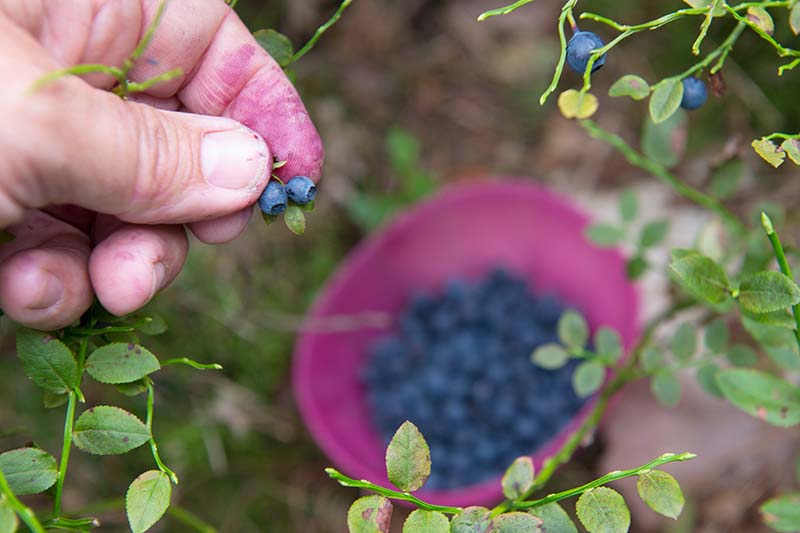
Then thaw the berries and place them in a blender with water and grind for a few seconds. Leave to sit for a few minutes, and the viable seeds will settle to the bottom.
Clean the seeds and sow in flats in a half and half mixture of sand and peat. If kept in a room that is 70°F and has ample light, germination will occur in three to four weeks. Seedlings can be transplanted into the garden after the last frost.
Don’t expect to be able to harvest berries the first year! It can take up to four years for a plant grown from seed to flower.
Read more about blueberry propagation here.
How to Grow Lowbush Blueberries
Find a location in part shade to full sun with room to space each plant two to three feet apart.
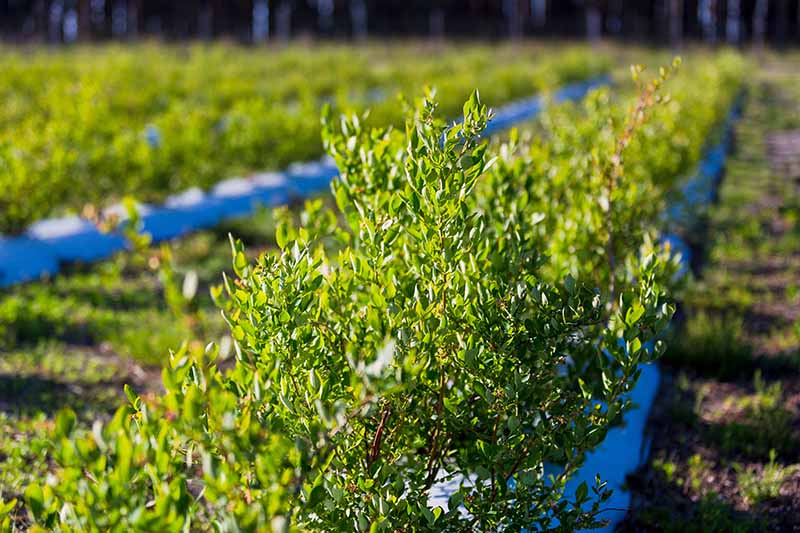
While they grow wild in dappled shade, a full sun location will provide the most abundant harvest. It is recommended to plant at least two shrubs, preferably distinct cultivars.
Blueberries can sometimes self-pollinate, but will have improved yields when planted with at least one other variety.
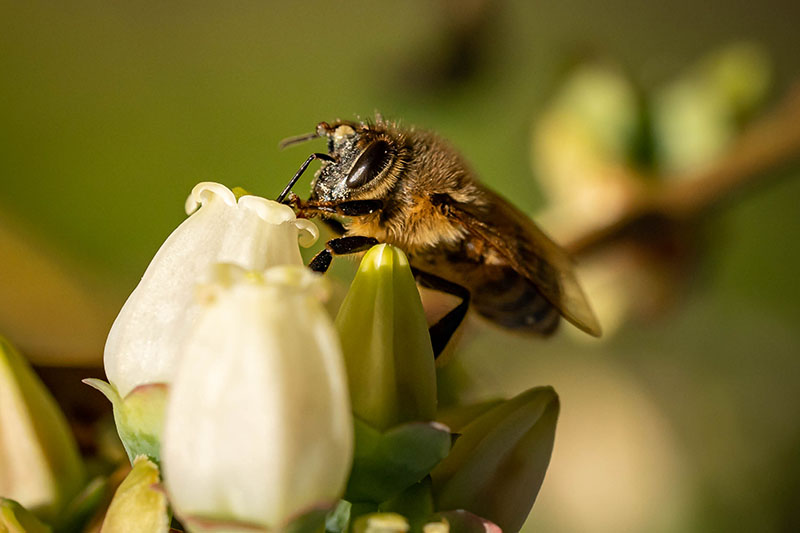
Perhaps most important to growing blueberries of any variety is to maintain the right soil conditions. They require organically rich, well-draining, acidic soil – preferably sandy loam – with a pH of 4.0 to 4.8.
Before amending your soil to adjust for pH, conduct a soil test through your local extension office to establish your baseline.
There are several ways to lower the pH of your soil organically, such as side dressing your plants with used coffee grounds or sprinkling some organic sulfur on the soil surface.
If you don’t want to worry about adjusting soil pH, one option is to grow them in containers. Just plant in a five gallon container with a soilless growing medium such as a half and half mix of peat and shredded pine bark, caring for them as you would for shrubs planted in the ground.

You can learn more about growing blueberries in containers in our guide.
Keep beds free from weeds and mulch plants with a layer of wood chips, pine needles, or pine bark to help regulate moisture.
Lowbush blueberries tolerate a wide range of temperatures and moisture, from dry, sunny climates with 20 inches of average annual rainfall, to cloudy maritime climates with 61 to 70 inches of rain per year.
Water regularly. Plants need one to two inches of water per week, especially in the first couple of years while they become established.
Drip irrigation can work well since it allows water to penetrate the soil and directly access the root zone.
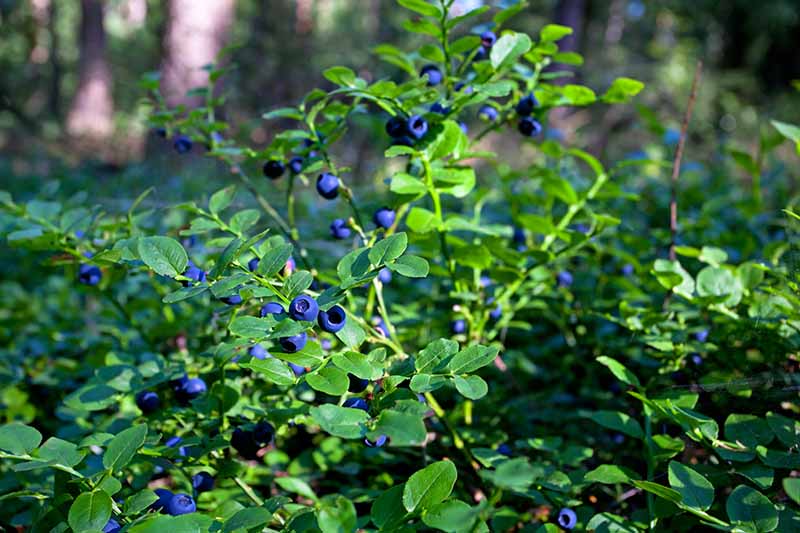
These shrubs love nitrogen. Adding blood meal, fish meal, or an organic fertilizer formulated for azaleas will be beneficial to maintain healthy plants.
Be sure to avoid using fertilizers that contain nitrogen in the form of nitrates as these can be toxic to these shrubs. These plants typically only need feeding once per year in the spring before they leaf out.
Instead of applying a synthetic fertilizer, I love planting blueberries with lupines. Lupine is a beautiful flowering legume which will fix nitrogen in the soil.
Additionally, it flowers around the same time as the berries, helping to attract pollinators.
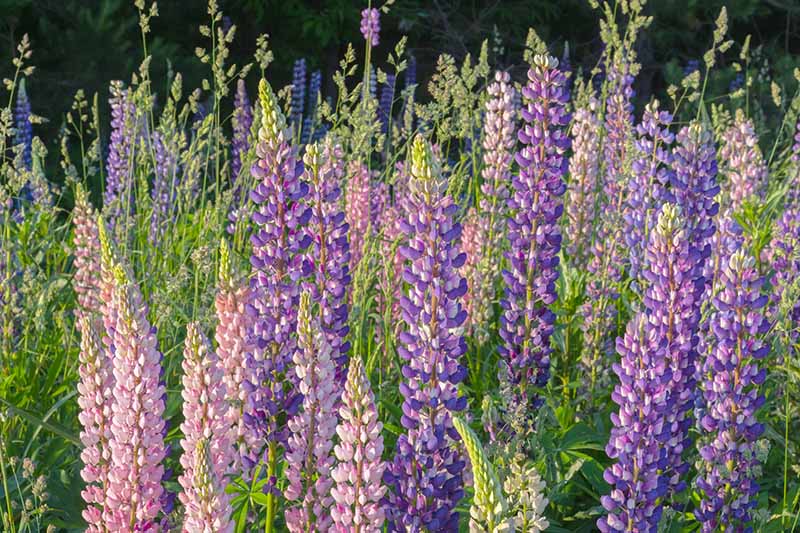
While it may be tempting to grow all your berries in one spot, it is best to avoid planting near raspberries and blackberries which require less acidic soil, need structures to support brambles, and have different spacing requirements.
Growing Tips
- Plant in acidic soil. Test your soil pH and amend with coffee grounds or sulfur as necessary.
- Mulch with a thick layer of wood chips, pine needles, or pine bark.
- Provide one to two inches of water per week in the absence of rain.
- Wait a year or two before harvesting berries.
Pruning and Maintenance
In order to maintain berry production, mature plants need to be pruned every other year. After harvest, remove older, less productive branches and any branches that show signs of disease.
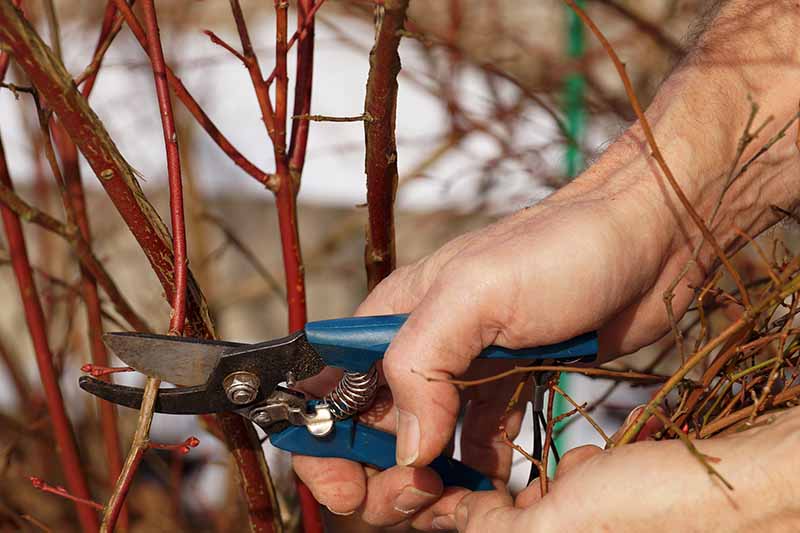
While it may be tempting to harvest the berries as soon as possible, it is best to wait at least a year after planting to allow the plant to develop a strong root system.
Flowers should be removed completely for at least one year after planting to encourage vigorous plant growth. The second year, remove about a third of the flowers.
You can harvest the entire crop each year beginning the third year after planting.
Lowbush Blueberry Cultivars to Select
V. angustifolium is the wild lowbush blueberry botanical species. These low growing shrubs produce sweet, edible berries, which are smaller than most cultivated varieties.

V. myrtilloides, which goes by names such as the sourtop or Canadian blueberry, and the velvetleaf huckleberry is a close relative of V. angustifolium, sometimes hybridizing in the wild.
Like V. angustifolium, it is also a low growing deciduous shrub with white flowers followed by small edible berries. It can be distinguished by tiny hairs covering the surface of the leaves.
Botanical species plants can sometimes be found in your local nursery or garden center. Look for plants described as lowbush, wild, or Maine blueberries.
You can also sometimes find wild blueberry sod for sale, generally at specialty nurseries. Sod provides dense cover with high yields of berries.
There are a few cultivars to look out for:
Blomidon
V. angustifolium ‘Blomidon’ was the first named lowbush cultivar bred for commercial growing. It was cultivated in the 1970s at the Agriculture Canada Research Station in Nova Scotia.
This variety is a vigorous grower with high yields of large uniform fruits that ripen in midsummer. It grows eight to 12 inches in height with spreading stems, dark green foliage, and white flowers in spring.
Brunswik
V. angustifolium ‘Brunswick’ features glossy blue-green foliage that deepens to showy scarlet-red in the fall.
It is a vigorous grower, producing an abundant harvest of small, sweet, firm berries in mid summer.
You can find plants from 18 months to four years old available at Nature Hills Nursery.
Burgundy
V. angustifolium ‘Burgundy’ has beautiful burgundy new growth which ripens to a gray-green color, turning bright orange and red in autumn.
This variety makes an attractive ground cover or low hedge.
The small tasty berries ripen in summer following white blooms. Very tolerant of cold, ‘Burgundy’ is hardy in Zones 2 to 8.
You can find two- to four-year-old year old ‘Burgundy’ plants available from Nature Hills Nursery.
Managing Pests and Disease
Lowbush types tend to be susceptible to similar problems as other species of blueberries.
While there are a number of issues that can crop up, there are also some simple ways to mitigate them.
Herbivores
In the wild, blueberries are enjoyed by all sorts of animals such as black bears, moose, birds, and white-tailed deer.
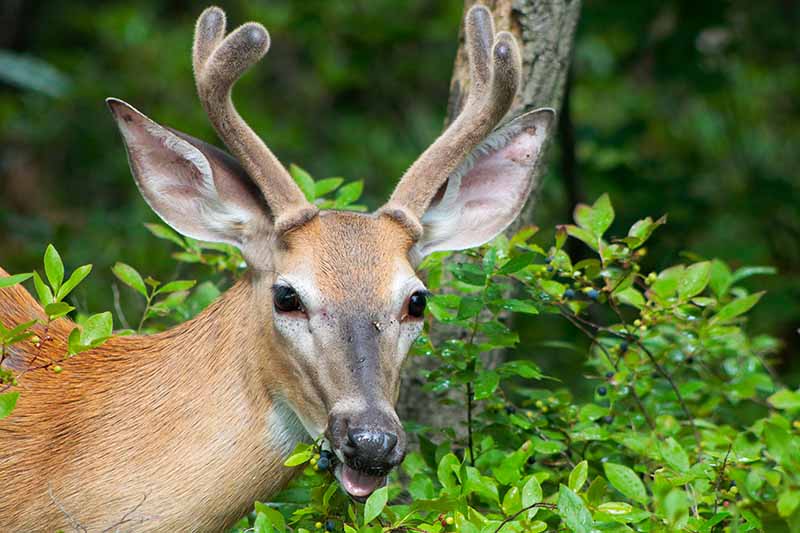
If you don’t want to share your crop with the wildlife, you may consider surrounding the bushes with cages or netting to protect them from birds and mammals.
Learn more about how to protect blueberries from birds in our guide.
Insects
Unfortunately, mammals and birds aren’t the only ones who like blueberries. There are a number of insects to watch out for that can cause great damage to your crop if left unchecked.
Fortunately, taking preventative measures like mulching and weeding can do a lot to help plants stay healthy and keep pests under control.
Blueberry Maggots
These little white maggots (Rhagoletis mendax) can infest fruits, spreading quickly through your harvest.
Try incorporating plants to attract parasitic wasps, a natural predator of these maggots. Dill, yarrow, and marigolds are all great choices.
You can also spray bushes with a homemade spray of cayenne pepper, garlic, and liquid dish soap.
Simply blend one garlic bulb in a quart of water with one teaspoon of powdered cayenne and a few drops of biodegradable soap and spray every few days until the infestation subsides.
Flea Beetles
Both the larvae and adult beetles (from the Chrysomelidae family) feed on foliage and in extreme cases can completely defoliate sections of the crop.
Burning as a method of pruning may help control flea beetles.
Incorporating a living mulch like clover will also help by interfering with the ability of the beetles to lay eggs in the soil.
Learn more about how to manage flea beetles here.
Spotted Wing Drosophila
This small fly (Drosophila suzukii) lays eggs in healthy fruit, potentially causing major damage to fruit production, especially late in the harvest season.
To learn more about dealing with this pest, check out our in-depth guide to organic management.
Disease
There are several fungal diseases that cause problems for foliage and can ultimately lead to decreased fruit production.
In all cases, when you notice discolored leaves, it is a good idea to pick off and dispose of these. Be sure to remove fallen debris often and keep the planting area clean.
You can also spray foliage with a homemade fungicide made with one ounce of horticultural oil and four teaspoons of baking soda mixed into a gallon of water.
You can reduce the risk of infection by watering in the morning and using drip irrigation to avoid wetting the foliage, pruning to increase air circulation, and mulching.
Here are a few of the conditions you may come across. You can use the preventative and treatment measures above to address each of these fungal diseases:
Leaf Rust
Caused by the fungus Pucciniastrum vaccinii, leaves develop yellow spots which turn brown and red over time.
The disease can spread quickly as the season progresses, with leaves eventually dropping from the plant, leading to a reduction in yields.
Septoria Leaf Spot
The fungus Septoria lycopersici causes spores to develop in wet conditions, and shows up as blistering on the underside of leaves.
You may notice small brown lesions on the stems and foliage with tan or gray centers. This infection is often more severe in young plants and can impact overall productivity.
Valdensinia leaf spot
This fungal infection (Valdensinia heterodoxa)causes entire stems to lose their leaves, resulting in loss of flowers and fruit.
Spots are 1/8 to 1/2 inch, round, and brown, often with the appearance of a “bull’s-eye.” This disease can spread rapidly to adjacent plants, especially in wet weather.
The fungus can overwinter in infected leaves.
Find more info on managing blueberry pests and diseases here.
Harvesting Lowbush Blueberries
After a year or two of removing the flowers, harvest by picking the small berries off of the shrubs in mid to late summer, when they are ripe.
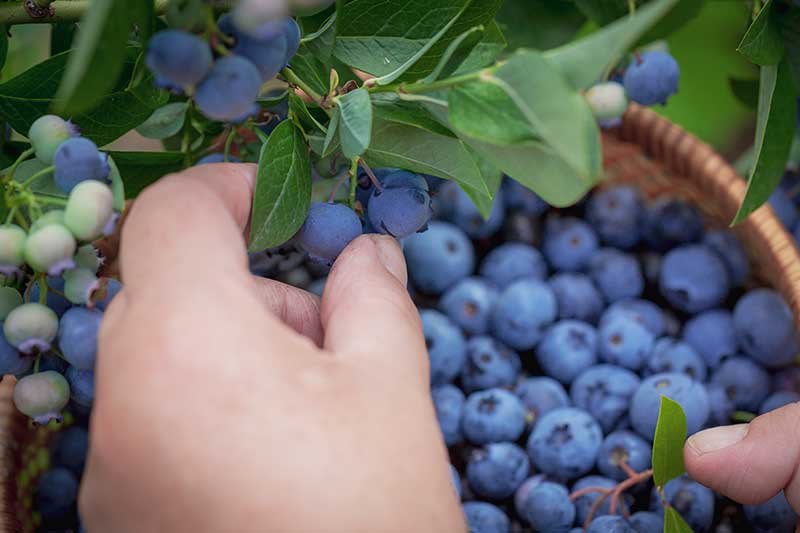
Wait until the berries turn a deep blue and appear plump and full. They should be easy to pick, no yanking required.
You can learn more about how to harvest blueberries in our guide.
Preserving
If you are somehow able to avoid eating them all as you pick them, or over the course of the next week, you can preserve the berries in so many ways.
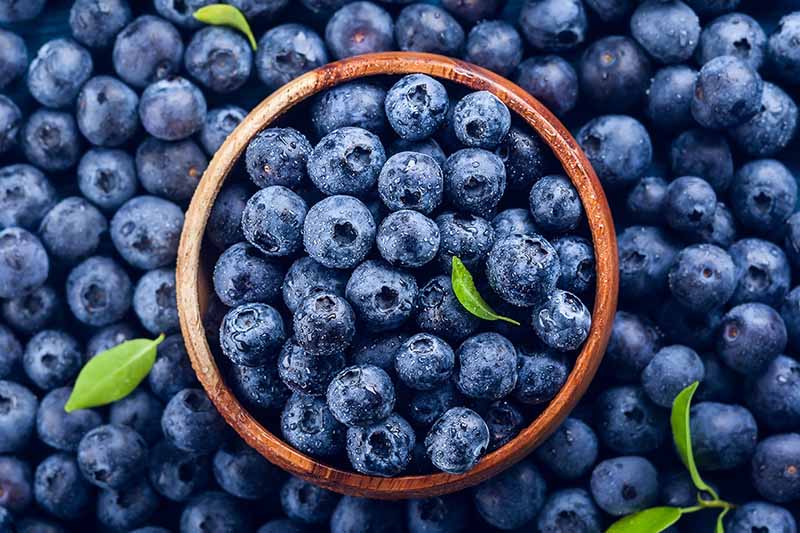
You can dry them, can them, or make blueberry jam. You can even infuse them in vinegar for a delicious dressing or marinade.

Blueberries can be dried in a dehydrator set on low for approximately 18 hours or baked in a preheated oven set to the lowest temperature for about three hours, until they are fully dry.
Leave to cool and store in an airtight container.
To make blueberry vinegar, place one part blueberries to two parts vinegar in a glass jar. Smash the berries with a fork, seal with a plastic lid, and give the jar a good shake.
Set in a cool location for a few days, shaking the jar daily. Strain the berries and boil the infused vinegar for about a minute, skimming off any debris that surfaces. Strain one more time and store in a cool dark location.

Personally, I typically like to freeze fresh blueberries and use them through the winter in smoothies and baking.
To freeze, wash and let the berries dry thoroughly. This is especially important if they may have been sprayed with any pesticides.
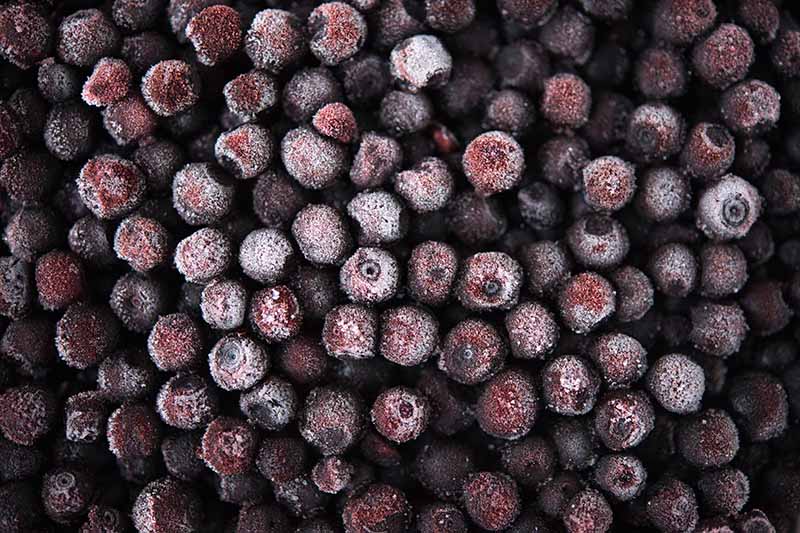
Next, spread them out in a single layer on a baking sheet and freeze for several hours.
When they are completely frozen, you can transfer them to a freezer bag for long term storage. The berries should keep for one to two years.
Of course there is something pretty special about homemade blueberry jam. For a detailed guide to jam making, check out this article on our sister site, Foodal.
Recipes and Cooking Ideas
There are so many creative ways to incorporate blueberries into cooking, both sweet and savory.
Pancakes, syrups, spreads, salad dressings, salsas, compotes, smoothies, cakes… the list goes on and on.
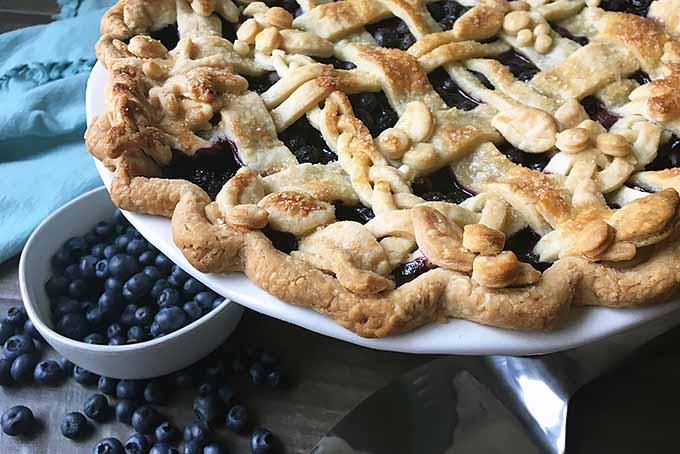
If you are looking for a fun summery dessert, you will love this mouthwatering recipe for blueberry pie from our sister site, Foodal.
Or get the day going with a refreshing blueberry breakfast popsicle. This recipe, also from Foodal, blends frozen yogurt with oats and blueberry jam for a sweet treat that the whole family will enjoy.
Quick Reference Growing Guide
| Plant Type: | Perennial berry | Tolerance: | Cold, frost, heavy snow |
| Native to: | Northeast US, east and central Canada | Maintenance: | Moderate |
| Hardiness (USDA Zone): | 2-8 | Soil Type: | Sandy loam |
| Season: | Summer | Soil pH: | 4.0-4.8 |
| Exposure: | Full sun to part shade | Soil Drainage: | Well-draining |
| Time to Maturity: | 2-3 years | Attracts: | Bees, birds, butterflies |
| Spacing: | 2-3 feet | Companion Planting: | Basil, lupine, rhododendron, strawberry, thyme |
| Planting Depth: | 1/4 inch (seeds), same depth as container (transplants) | Avoid Planting With: | Plants that prefer alkaline soil |
| Height: | 6-24 inches | Family: | Ericaceae |
| Spread: | 2 feet | Genus: | Vaccinium |
| Water Needs: | Moderate | Species: | Angustifolium, myrtilloides |
| Common Pests: | Birds, blueberry maggots, blueberry spanworms, deer, flea beetles, spotted wing drosophila, thrips | Common Diseases: | Leaf rust, powdery mildew, septoria leaf spot, valdensinia leaf spot |
Worth the Wait
I have had so much fun watching the wild blueberries in my yard grow and thrive over the last few years.
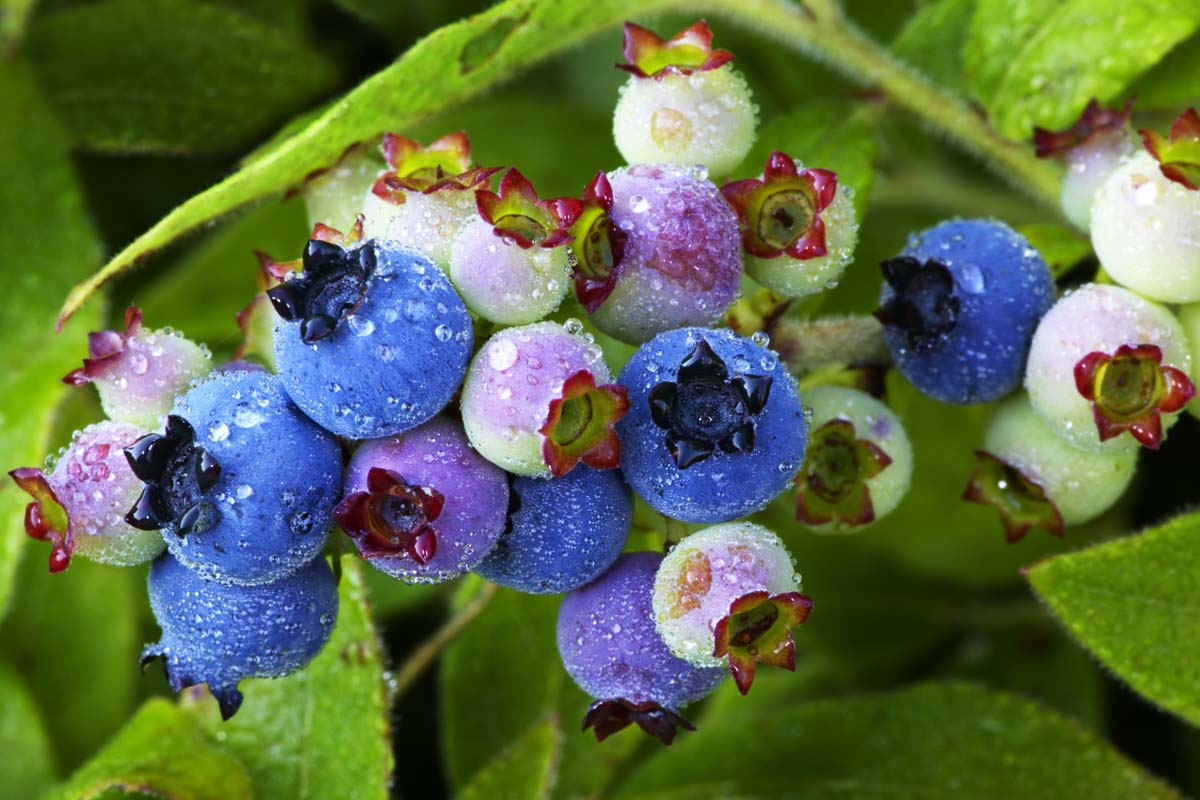
After just a couple of seasons of patience, you too will be rewarded for your efforts with juicy, delicious fruits for 20 years or more.
Are you growing lowbush blueberries in your garden? Share your experience in the comments below.
And for more information about growing blueberries in your garden, have a look at these guides next:

